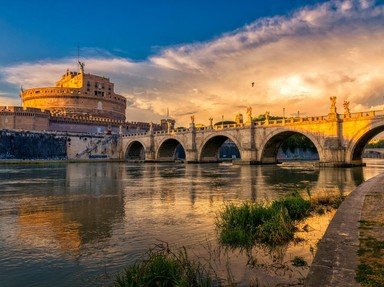Quiz Answer Key and Fun Facts
1. An artificial hill of Rome was used for the city's defenses and as a storage of numerous amphorae, some of them labeled with "tituli picti", with the goods that came from Rome's provinces. What is the name of that hill?
2. Tituli picti is something of a modern device. Each successful workshop or business had its specific label and code to prevent frauds and forgeries. In Rome what happened to those who engaged in in such frauds and fakes?
3. In which year did Trajan open his marketplace?
4. As Rome flourished, more and more people desired to live in the city itself. and suddenly it became too crowded. Hence, more and more insulae were built. Insulae usually had 3-7 floors and some even had 13 floors. The higher the floor, the lower the rent.
5. What was the most common abscess in ancient Rome?
6. Every household in ancient Rome had its furnace or oven.
7. From which province did the Romans get most olive oil?
8. Which vegetable was believed to cure cancer?
9. How many people could the Flavian Amphitheater accommodate?
10. Garum was a type of fish sauce popular in Ancient Roman society. What was it also called?
11. One can still see the ruins of a garum factory at the site of Baelo Claudia, in (A) _________, just outside the small town of (B) __________.
12. In Rome, what were streets that were wide enough for one-way cart traffic called?
13. A central opening in the roof of the atrium that let in light and air was called _________.
14. A bandage that was put around the hips and was worn by both men and women was called:
15. What was a slave that was trained to be a barber and a hairdresser called?
16. Which Roman emperor received a cognomen that referred to Roman military sandals?
17. The marriage "confarreatio" was dissolved by divorce with less ease than the marriage "___________" .
18. After which year did every colony in Italy gain municipal rights?
19. A father could in theory sell or murder his own child, but by the time of the Republic that law was not used in practice any more.
20. A slave gate keeper in Rome was called __________
21. The publicani were holders of state income and properties, generally contractors and tax holders. By whom were their leases approved?
22. Where was the Subura Roma, known for its squalid quarters, noisy workshops and wanton residents, located?
23. Which of these tunicae was an Equestarian most likely to wear?
24. Which the Roman goddess was the Goddess of Wisdom and Knowledge?
25. When a boy reached the age of 16, he would study rhetoric in public lectures. There were two main types of rhetorical exercise. What were their names?
Source: Author
Kserkso
This quiz was reviewed by FunTrivia editor
bloomsby before going online.
Any errors found in FunTrivia content are routinely corrected through our feedback system.
